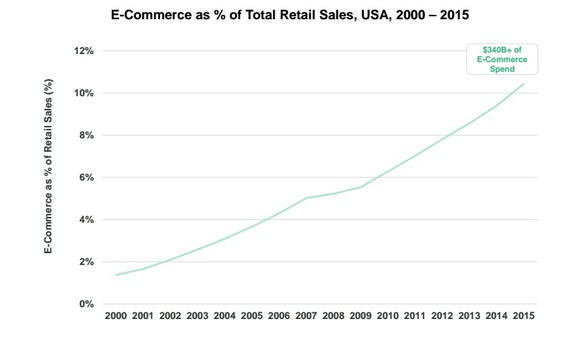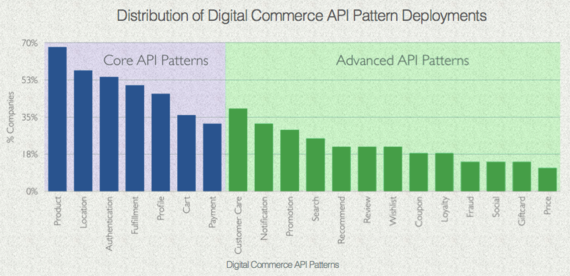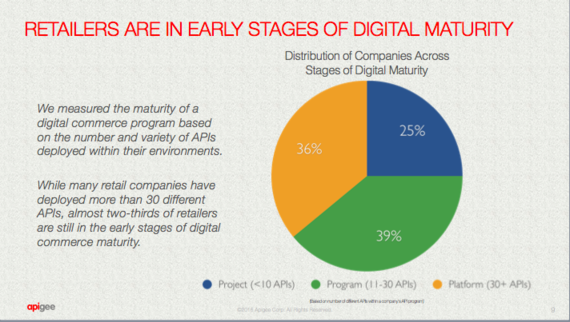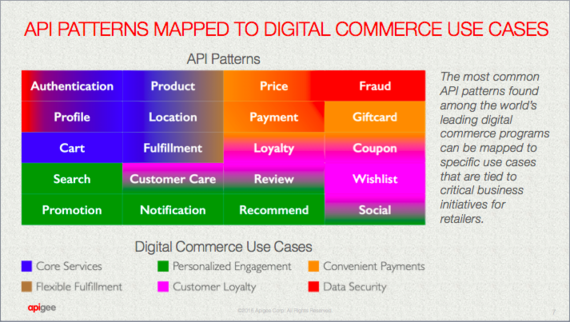The line between digital and physical is blurring. Nowhere is this more evident than retail, as established brands like Walgreens and Burberry up their digital game to attract new customers while online players like Amazon and Warby Parker continue expanding offline with physical stores opening in major metropolitan areas.
It's clear new technologies and strategies based on well managed APIs, cloud infrastructure, and agile development practices are behind much of the transformation we're seeing in retail, but how -- and why?
To better understand these trends and implications, my employer, API management provider Apigee, recently examined the patterns driving API digital transformation across 30 global retailers, 700 individual APIs, and nearly 100 billion API calls. These findings have recently been published in the Apigee State of APIs in Retail report.
Having had the opportunity to work with dozens of Fortune 500 executives on their digital transformation efforts, API management, and multi-cloud strategy over the past few years, I've found that many companies still struggle with thinking strategically about APIs and digital initiatives management. The findings of Apigee's State of APIs in Retail report, which I outline below, provide a roadmap for any company launching digital initiatives today.
Start at the Core
The first finding of the report is simple and straightforward: Customers and partners want to do business with companies for the exact same reasons they always have -- and APIs simply make this faster and much easier.
APIs are a foundational technology for digital commerce. They allow retailers to create new digital services and experiences as retailers evolve from web to mobile. As illustrated below, executives in retail -- and indeed any sector of digital commerce -- are well served by skipping the planning phase and jumping right into building the following "core" APIs on day one:
/Product API
Customers want to know what you are selling. Make it easy for them to find out! This is exactly why Product APIs exist.
Most retailers operate a patchwork of backend systems housing various key pieces of information about their products: SKUs, descriptions, catalogs, inventory, and price, to name a few. As any retailer who has undergone digital transformation can tell you, untangling the mess is no small feat.
According to our findings, stitching these various pieces together into a easily consumable Restful API is the clear first step for introducing APIs in a retail setting. This enables retailers to use the API to power rapid development of mobile and web apps, and partner or affiliate programs. It's a core building block of building modern digital retail experiences.
/Location API
Once customers know what they can buy, the next thing they want to know is where to buy it. Retailers certainly want to give them the option to buy right then and there on their device, but many customers want to see items in person before purchasing. How do companies help customers find their nearest location? Location APIs.
Across the board, Location APIs are a core API for nearly all retail and commerce businesses leveraging APIs to build digital experiences.
/Authentication API
Security is the lynchpin of a great digital experience. Using an OAuth2 authentication API is a key step towards ensuring the safety of the customer's and the enterprise's security. It's no wonder this is one of the very first APIs every retailer puts into place.
/Fulfillment
Fulfillment is where the customer's digital experience with a brand crosses over into the real world. Did the product get delivered in time? Is flex fulfillment like in-store or curbside pickup an option? Are there integrations with a third party delivery service? Like Product APIs, Fulfillment APIs often take an enormous amount of complexity and hide it behind a simple interface. This way, developers can focus on creating the experiences, not navigating the nitty-gritty of an enterprise's data model.
/Profile
Every retailer want to know their customers, and the customer wants that too. Profile APIs help retailers show users what they have purchased (or otherwise prefer) and make it possible to provide personalized offerings that are relevant to their individual tastes.
/Cart /Payment
All of this interaction between the customer and a retailer's products is great, but at the end of the day -- transactions are at the heart of any business. Customers want a product or service, and retailers want them to complete the purchase. Today, however, creating a simple way for customers to select items and purchase by credit card, PayPal, Apple Pay, Google Pay, or any other transaction method is table stakes.
When it comes to building digital programs in retail, the data is clear: show customers relevant products and services, make it easy to get more information about any product, make pickup or deliver fast and seamless, and make dead simple to complete the transaction.
The Path to Platforms
Great digital retailers don't stop with few core APIs. Findings in the State of APIs in Retail report reveal a clear maturity pattern for retailers building digital experiences as they go from a few initial projects to a more mature program, and eventually a full-blown platform.
Once the initial set of core APIs are built, retailers become more advanced in their digital offerings and add functionality that provides even deeper levels of personalized engagement and customer loyalty, as well as enhanced security features.
No matter the type of retail business, the most advanced API programs in retail leverage the exact same types of data flows to drive great customer and partner engagement. APIs serve as an abstraction layer that makes clear the commonality of the experiences retailers are looking to provide their customers.
Even more importantly, APIs underscore the fact that the difference in digital prowess is not a function of simply having this or that set of capabilities, but rather how well an enterprise leverages these capabilities to create value for customers and the firm.
The State of APIs in Retail report offers a great visual overview of these capabilities. Note in the graphic below how many capabilities -- not just the core set -- can be used to across a variety of use cases. This clearly illustrates the value of making each individual capability simple and easy to use; doing so means a retailer can quickly create, test, and scale new customer experiences.
Leverage Ecosystems to Escape Constraints and Accelerate Digital Business
Sometimes the data you can't see says more about a market than what's immediately visible. In addition to retailers building APIs themselves, there is a large and rapidly-growing ecosystem of APIs designed to complement and augment the core capabilities of retailers is cropping up today as well.
Increasingly, it makes more sense to leverage the APIs of third-party service providers rather than building bespoke systems. Why build mapping when you can get it from Mapquest? Same goes for processing payments with First Data or Vantiv, creating loyalty programs with Belly, or shipping with Pitney Bowes. These companies and others are helping retailers move faster and focus on what matters -- building great digital experiences (before the competition does).
The growth of this ecosystem is where much of the exciting work around business model transformation with APIs begins. It also underscores the extent to which the future of retail will be constrained by a brand or retailer's ability to execute heavy weight IT functions. Once only available to a small few, the rise of API ecosystems makes shipping, payments, loyalty programs, credit and other components of digital are available 'as a service' to the entire sector.
Implications for Healthcare, Financial Services, Telcos and others
The competitive imperatives of digital are forcing brands and retailers to lead the way in innovating their business models and adopting APIs, cloud infrastructure, and faster methodologies to provide customers with great experiences -- but this trend is well on its way to disrupting the other industries too.
At the end of the day, we are all being trained to expect fast, easy, self-service access to products and services -- and whether they're ready or not, companies operating in healthcare, financial services, telcos and others sectors are being driven to respond. While there are clearly differences in the specific use cases customers will require of these service and product providers, executives in these industries have much to learn from their colleagues in the retail space.
Irrespective of the industry, customers want to engage with a company around the products and services that are relevant to them, and they expect the entire experience is delivered simply, quickly, and securely with minimal friction or hassle.
How will they do it? By looking to the retail industry while creating and managing APIs with very similar capabilities as described here.






